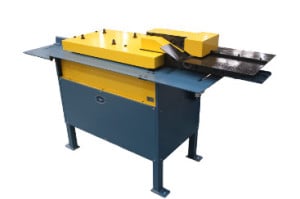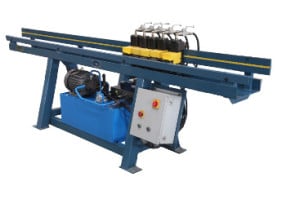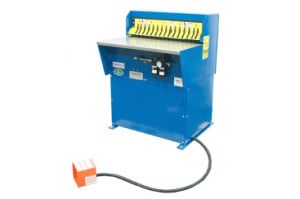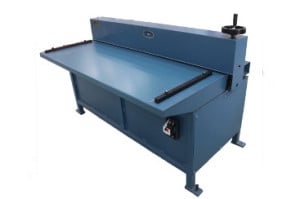In part 1 of Bending Without the Bender, we took a look at some seams and assembly methods that can be more efficiently shaped using roll forming techniques, instead of a press brake or hydraulic bender.
Although your hydraulic bender will still be a staple for any HVAC or sheet metal fabrication shop, there are some particular machines that can benefit your process. While the bender is dedicated to… well, bending, it isn’t always the most productive option for forming seams or other tight shapes. Roll formers and notchers, on the other hand, are both specialized for certain forming operations critical to ductwork fabrication.
The Roll Former
Many locks and seams have more complex shapes than can be easily and quickly formed using the right roll former and associated tooling. Although “roll former” is a term that could suit many machines with roll tooling, there are some machines that are designed and dedicated to producing HVAC components, like Drive or S Cleat. These HVAC roll formers are typically compact, taking up about 8 ft2 of floor space on the shop floor.
Depending on the tooling arrangement, these formers can handle more than just cleat. Since most fabricators find the need to produce assembly locks, like Pittsburgh or Snap Locks, the machines are designed to accommodate those operations. For unique forming operations used in other industries like roofing, sign fabrication, or other metal building, some OEM’s are able to work with customers to create custom tooling.
The Notcher
Before rectangular duct sections can be joined, and before rectangular duct sections can be assembled, they have to actually be rectangles. Your bender will be the best tool for shaping the right angles, but certain parts must have the corners notched first to make the appropriate shape.
Notching can be done by hand with a notcher tool, with each notch being clipped out of the sheet metal based on the pattern laid on the sheet. However, if business is good and production demand is high, it can be very costly to notch by hand. Instead, shops can use a machine notcher. These machine notchers are often outfitted with multiple heads that can be easily set up so that notching becomes a repeatable and efficient process.
The Cleat Bender
While the roll former can be outfitted to handle production on a number of different shapes, if your operation only needs a basic cleat edge, you’re better off relying on a machine specialized for that use. A cleat bender is designed to make repeated cleat forming easier through a simple two-step process. After adjustment, the operator simply positions the sheet and activates the bender, typically by using a pedal so the sheet can be kept steady.
One feature that can also be useful for shops with limited floor real estate is that some cleat benders, like Roto-Die’s CB-30, do not require electricity and are instead linked only to a compressed air connection. This leaves some options for fabricators who need to dedicate electrical outlets to other machinery.
The Beader
As we discussed in our post The Art of Duct Stiffening: Beading vs. Cross-braking, a beader can be an excellent companion to a hydraulic bender, since nearly every duct project will require stiffening and SMACNA dictates that it’s a standard for sheet metal production. Freeing up your shop’s bender can be vital when production volumes are high, and the beader helps you keep workflow moving.
What equipment fits into the production line for your operation? Comment below to tell us how you handle the volume!





